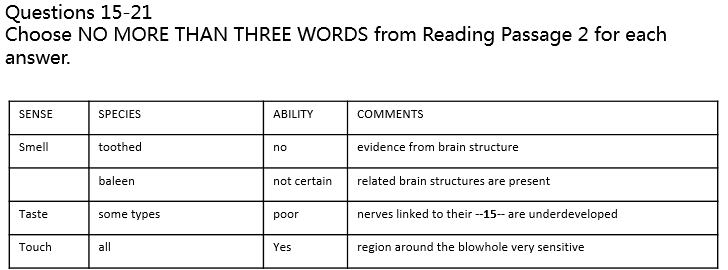自学雅思的阅读备考方法一文描述了在自学的情况下,我们应该怎样备考雅思阅读。无论你报补习班还是自己复习,都应该做到知己知彼百战不殆。下面小编就和大家分享自学雅思的阅读备考方法,来欣赏一下吧。
自学雅思的阅读备考方法
雅思阅读主要是先按各种题型讲解题方法。雅思的阅读可以大致分成4类:
1。overview questions:List of headings
2。viewpoint questions: T/F/NG
3。summarizing questions: summary
4。specific questions: multiple choice; short answer; sentence completion; flow chart; table completion; matching
以上按顺序难度递减。
每种题型都有其解题的方法步骤以及注意事项,这是没有接触过雅思阅读的学生必须学的(不论程度怎样!!!)。因为在雅思阅读中不仅要做得对,更要做得快,如果不熟悉题型,很可能来不及做或掉入题目的陷阱中!!!
至于每种题型的方法这里就不详细说了,大家可以收集市面上的资源。但有一点值得注意:
在选购了自己觉得不错的书后(一定要是讲方法的),可以学习书中的方法并分析书中所提供的试题,因为阅读不是会了方法就一定能做对的,必须要通过练习来感悟,学以致用!!!
那么有人会问,哪些试题比较权威呢?!
这个问题太简单了。在学习了讲题方法后,买本剑3,学一个题型后就到剑3中把这种题型都做一遍(即把剑3当作单项训练),在掌握各种题型的解题方法后(剑3的题目也练完了),买本剑4,把剑4当作实际考试来做,从中再积累点综合解题的心得。
总结一下:先学解题方法并通过剑3巩固,再做剑4进一步训练综合解题的能力,这样是最有效的也是最捷进的了。
有的学生又要问,自己怎么自学呢?!
市面上有剑3和剑4试题的详解还附有文章的译文和重点单词,所以大家大可以自学。
对于已经同大学英语四级或具有同等水平的学生来说,直接学解题方法并通过剑桥的试题训练就可以达到一个不错的分数。如果是想拿高分的(7分以上),那么在做剑桥的同时,可以把里面的文章精读,扩大词汇量,把文章多读几遍,读透,提高综合的阅读能力。两本书G类试题不算的话,有24篇长文章,若能坚持读完那么综合的阅读能力一定能提高!!!
对于尚未达到大学英语四级水平的学生,建议先不要做剑桥。我建议可以买些其他的难度稍低的阅读书来提高一定的阅读量提高一下英语基础。这一步是为了打基础,所以大可选用非雅思的阅读,但是如果能选用难度略低,有符合雅思阅读要求的题目当然是最好的。同样也是要精读文章,积累词汇量和看长文章的能力,在打下了一定的基础后,再来研究真实的雅思试题,效果会更好!!!
需要说明的是,在没有了解雅思的情况,想通过自学后去考试的同学,请不要急于做真题,因为雅思的真题很少,一口气做完了,后面就没有权威的题目了,所以必须在对雅思有一定的了解,掌握了一定的方法后再去拿真题来巩固,这样比较好。
以上就是自学雅思的阅读备考方法的全部内容,同学们一定要根据自身的特点进行备考计划的制定。不管你是报补习班还是要自己备考雅思,我们都应该做到知己知彼百战不殆。雅思阅读是雅思4科目中较容易在短时间内进行提分的科目,我们应该有效利用这个特点。
雅思阅读材料:日本科学家克隆出581只相同的老鼠
Biologists in Japan have cloned 581 mice from one original donor mouse, Livescience reported. The scientists made the mice over 25 generations of cloning; that is, from making clones from clones from clones, 25 times over。
根据Livescience的报道,日本生物学家用一只小鼠的基因供体克隆出581只小鼠。这些科学家们克隆了25代小鼠,即:用克隆鼠克隆新的小鼠,一共克隆了25次。
They could probably make animal clones indefinitely, the research team wrote in a paper published last week in the journal Cell Stem Cell。
研究团队在上周发表在《干细胞》期刊中的论文称,他们很有可能会让动物无休无止地克隆下去。
Really. Check out the last sentence of their abstract: "Our results show that repeatediterative recloning is possible and suggest that, with adequately efficient techniques, it may be possible to reclone animals indefinitely."
是这样吗?我们来看看论文摘要的一句话:“我们的研究结果证明多代克隆是可能实现的。如果技术到位,那么克隆出无穷多代的动物都是可能的。”
The 581 cloned mice were made using an improved version of somatic cell nuclear transfer, the technique that created Dolly the cloned sheep in 1996.这581只小鼠是用改进后的体细胞克隆技术克隆得到的,这一技术最早是在1996年克隆多莉时发明的。
Previously, researchers using somatic nuclear cell transfer would get fewer and fewer animals every time they tried to make a clone from a clone. Eventually, they wouldn't get any new clones at all. Cloned mammals also often died sooner than their non-clonedcounterparts。
在此之前,运用体细胞克隆技术反复克隆动物时,被克隆的动物数量会越来越少,直到最终无法克隆出新动物为止。被克隆出的哺乳动物也会比非克隆的同类动物死得更早。
The cloning team protected the mice's DNA from the genetic abnormalities they (the humans) think reduced the efficiency of previous cloning efforts. The researchers didn't lose any cloning efficiency over their 25 generations, they reported, and their cloned mice lived normal lifespans of about two years。
这支研究团队保护了小鼠的基因,使其不发生基因异常。他们认为,基因异常正是降低克隆形成率的罪魁祸首。研究者称,这25代小鼠的克隆过程中克隆形成率并没有降低,小鼠的寿命也很正常,约能生存两年时间。
Cloning could help reproduce animals for farming or conservation, Sayaka Wakayama, a biologist at the RIKEN Center for Developmental Biology who led the cloning study, said in a statement。
日本理化研究所的生物学家若山清香是这次研究的负责人,他在一个声明中提到,克隆技术可以繁殖动物,为农业和动物保护服务。
This isn't the first time Wakayama has made some big strides in cloning. He previously cloned mice from bodies of mice that had been frozen for 16 years。
这已经不是若山清香在克隆技术上的个重大成就了。此前他曾经以一只冰冻了16年的小鼠为供体克隆出了一只小鼠。
雅思阅读材料:美学者发明可视眼镜
High-tech glasses developed at Washington University School of Medicine in St. Louis may help surgeons visualize cancer cells, which glow blue when viewed through the eyewear.
The wearable technology, so new it's yet unnamed, was used during surgery for the first time today at Alvin J. Siteman Cancer Center at Barnes-Jewish Hospital and Washington University School of Medicine.
Cancer cells are notoriously difficult to see, even under high-powered magnification. The glasses are designed to make it easier for surgeons to distinguish cancer cells from healthy cells, helping to ensure that no stray tumor cells are left behind during surgery.
"We're in the early stages of this technology, and more development and testing will be done, but we're certainly encouraged by the potential benefits to patients," said breast surgeon Julie Margenthaler, MD, an associate professor of surgery at Washington University, who performed today's operation. "Imagine what it would mean if these glasses eliminated the need for follow-up surgery and the associated pain, inconvenience and anxiety."
Current standard of care requires surgeons to remove the tumor and some neighboring tissue that may or may not include cancer cells. The samples are sent to a pathology lab and viewed under a microscope. If cancer cells are found in neighboring tissue, a second surgery often is recommended to remove additional tissue that also is checked for the presence of cancer.
The glasses could reduce the need for additional surgical procedures and subsequent stress on patients, as well as time and expense.
Margenthaler said about 20 to 25 percent of breast cancer patients who have lumps removed require a second surgery because current technology doesn't adequately show the extent of the disease during the first operation.
"Our hope is that this new technology will reduce or ideally eliminate the need for a second surgery," she said.
The technology, developed by a team led by Samuel Achilefu, PhD, professor of radiology and biomedical engineering at Washington University, incorporates custom video technology, a head-mounted display and a targeted molecular agent that attaches to cancer cells, making them glow when viewed with the glasses.
In a study published in the Journal of Biomedical Optics, researchers noted that tumors as small as 1 mm in diameter (the thickness of about 10 sheets of paper) could be detected.
Ryan Fields, MD, a Washington University assistant professor of surgery and Siteman surgeon, plans to wear the glasses later this month when he operates to remove a melanoma from a patient. He said he welcomes the new technology, which theoretically could be used to visualize any type of cancer.
"A limitation of surgery is that it's not always clear to the naked eye the distinction between normal tissue and cancerous tissue," Fields said. "With the glasses developed by Dr. Achilefu, we can better identify the tissue that must be removed."
In pilot studies conducted on lab mice, the researchers utilized indocyanine green, a commonly used contrast agent approved by the Food and Drug Administration. When the agent is injected into the tumor, the cancerous cells glow when viewed with the glasses and a special light.
Achilefu, who also is co-leader of the Oncologic Imaging Program at Siteman Cancer Center and professor of biochemistry and molecular biophysics, is seeking FDA approval for a different molecular agent he's helping to develop for use with the glasses. This agent specifically targets and stays longer in cancer cells.
"This technology has great potential for patients and health-care professionals," Achilefu said. "Our goal is to make sure no cancer is left behind."
Dr. Achilefu has worked with Washington University's Office of Technology Management and has a patent pending for the technology.
The research is funded by the National Cancer Institute (R01CA171651) at the National Institutes of Health (NIH).
透过一副特制的高科技眼镜,医生小心切除闪着蓝光的癌变组织……当地时间2月10日,一台特殊的外科手术在美国密苏里州圣路易斯市一家医院里进行,借助这项刚刚问世的可视技术,原本几不可见的癌细胞变得无所遁形。
据美国媒体报道,这副能够“看见”癌细胞的眼镜由华盛顿大学(W U)放射学和生物医学工程学教授塞缪尔•阿基里弗教授领队研发成功,在理想状态下,它可以帮助外科医生在手术时一次性彻底切除所有癌变组织。
众所周知,即使置于高性能的显微镜下,癌细胞也难以被发现。但有了这副眼镜之后,医生能够轻松区分健康细胞和癌细胞,从而确保首次手术时不会遗漏任何癌变组织,进行二次切除手术以“查缺补漏”的可能性也由此大大降低。
据介绍,使用时,需要先把一种特定的分子药剂涂抹在肿瘤及其周边组织上,这种药剂会附着于癌细胞、令其发出肉眼不可见的光芒,然后,主刀医生戴上一个形似眼镜的头盔式显示器,通过自定义视频技术,即可看清癌细胞分布于何处。
“目前,我们尚处于研究初期,未来会进行更多的改进和测试工作。”乳腺外科医生朱莉•马格塔勒是10日进行手术的主刀大夫,同时也是个在实际操作中使用癌细胞可视眼镜的人,“一想到这项新技术将令病患获益良多,我们就干劲十足。”
依据现在的医护流程,外科医生手术时需要切除肿瘤及其附近组织,而这些组织中可能存在、也可能不存在癌细胞。随后,切除下的组织标本被送往病理实验室接受检验,如果在其中发现癌细胞,则需进行第二次甚至多次手术,直至癌变组织被完全切除。
据马格塔勒介绍,依靠现有的技术,无法准备判定癌变组织的全部范围,所以大约20%至25%的乳腺癌患者接受首次手术切除肿瘤后,还需经受第二次手术。
“借助这种癌细胞可视眼镜,可以在首次手术时一次性切除所有癌变组织。这意味着,没有必要再进行后续手术,病人也无需承担随之而来的病痛和手术费用。”马格塔勒希望,这项新技术能够降低、甚至完全消除二次手术。
2020自学雅思的阅读备考方法
下一篇:2020一个月雅思阅读怎么复习






